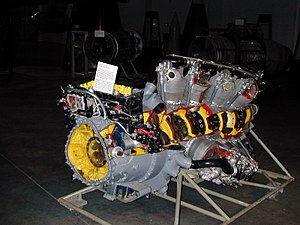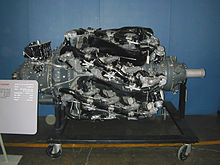Pratt & Whitney R-4360 Wasp Major
This article needs additional citations for verification. (January 2009) |
| R-4360 Wasp Major | |
|---|---|

| |
| Pratt & Whitney R-4360 Wasp Major (sectioned) | |
| Type | Four-row Radial engine |
| National origin | United States |
| Manufacturer | Pratt & Whitney |
| First run | 1944 |
| Major applications | Boeing 377 Boeing B-50 Superfortress Boeing C-97 Stratofreighter Convair B-36 Fairchild C-119 Flying Boxcar Hughes H-4 Hercules |
| Number built | 18,697 |
| Developed from | Pratt & Whitney R-2180-A Twin Hornet |
| Developed into | Pratt & Whitney R-2180-E Twin Wasp E |
The Pratt & Whitney R-4360 Wasp Major was a 28-cylinder four-row radial piston aircraft engine designed and built during World War II, and the largest-displacement aviation piston engine to be mass-produced in the United States. It was the last of the Pratt & Whitney Wasp family, and the culmination of its maker's piston engine technology, but the war was over before it could power airplanes into combat. It did, however, power many of the last generation of large piston-engined aircraft before the turbojet, and equivalent and superior output level turboprop powerplants like the Allison T56 took over.[1]
Design and development
The R-4360 was a 28-cylinder four-row air-cooled radial engine. Each row of seven air-cooled cylinders possessed a slight angular offset from the previous, forming a semi-helical arrangement to facilitate effective airflow cooling of the cylinder rows behind them, inspiring the engine's "corncob" nickname. A mechanical supercharger geared at 6.374:1 ratio to engine speed provided forced induction, while the propeller was geared at 0.375:1 so that the tips did not reach inefficient supersonic speeds.
Although mechanically reliable in flight, it developed an unenviable reputation for in-flight fires, particularly in its Boeing Stratocruiser application, and in addition the Wasp Major was maintenance-intensive. Improper starting technique could foul all 56 spark plugs, requiring hours to clean or replace.
Engine displacement was 4,362.50 cu in (71.489 L), hence the model designation. Initial models developed 3,000 hp (2,240 kW), and later models 3,500 hp, but one model delivered 4,300 hp (3200 kW) using two large turbochargers in addition to the supercharger. Engines weighed 3,482 to 3,870 lb (1,579 to 1,755 kg), giving a power-to-weight ratio of 1.11 hp/lb (1.83 kW/kg).
Wasp Majors were produced between 1944 and 1955; 18,697 were built.
A derivative engine, the Pratt & Whitney R-2180-E Twin Wasp E, was essentially the R-4360 "cut in half". It had two rows of seven cylinders each, and was used on the postwar Saab 90 Scandia airliner.
Variants

- R-4360-4 - 2,650 hp (1,976 kW)
- R-4360-20 - 3,500 hp (2,610 kW)
- R-4360-25 - 3,000 hp (2,237 kW)
- R-4360-41 - 3,500 hp (2,610 kW)
- R-4360-51 VDT - "Variable Discharge Turbine" 4,300 hp (3,210 kW). Intended for B-36C. Used on Boeing YB-50C Superfortress. 2-Power recovery turbines.
- R-4360-53 - 3,800 hp (2,834 kW)
- R-4360-B3 - 3,500 hp (2,610 kW)
- R-4360-B6 - 3,500 hp (2,610 kW)
Applications
Engines on display

- An R-4360 Wasp Major is on display at the Air Zoo in Kalamazoo, Michigan. The museum additionally displays a cutaway R-4360-4.[citation needed]
- An R-4360 Wasp Major cutaway view is on display at the Museum of Aviation in Warner Robins, Georgia.[2][failed verification]
- An R-4360 (TSB1-G) Wasp Major is on display at the New England Air Museum, Bradley International Airport, Windsor Locks, Connecticut.[3][failed verification]
- Hill Aerospace Museum at Hill Air Force Base, Utah—electric driven cutway[4]
- Cavanaugh Flight Museum, Addison, Texas[5][failed verification]
- Boeing Aviation Hangar, Steven F. Udvar-Hazy Center (Smithsonian), Chantilly, Virginia[6]
- Mid America Museum of Aviation and Transportation, Sioux City, Iowa [7]
- R-4360 Wasp Major cutaway on display at University of Central Missouri, Aviation Department, Warrensburg, MO [8][failed verification] also at Evergreen Aviation and Space Museum in McMinneville, Oregon
- Wasp Major engine cut away training engine is on public display at Hiller Aviation Museum, San Carlos Airport, San Carlos, California located about half way between San Francisco and San Jose CA along the Bayshore 101 freeway.
- Wasp Major engine on display at the Florida Air Museum in Lakeland, Fl. [5]
- Wasp Major engine cutaway is on display at the Boston Museum of Science[9]
Specifications (R-4360-51VDT)

General characteristics
- Type: 28-cylinder supercharged air-cooled four-row radial engine
- Bore: 5.75 inches (146 mm).
- Stroke: 6.00 inches (152 mm).
- Displacement: 4,362.5 cubic inches (71,489 cm3).
- Length: 96.5 inches (2,450 mm).
- Diameter: 55 inches (1,400 mm).
- Dry weight: 3,870 pounds (1,760 kg).
Components
- Valvetrain: Poppet, two valves per cylinder
- Supercharger: Gear-driven single stage variable speed centrifugal type supercharger
- Turbocharger: General Electric CHM-2
- Fuel system: Bendix-Stromberg PR-100E2 pressure carburetor
- Fuel type: 115/145 Aviation gasoline
- Oil system: Dry sump
- Cooling system: Air-cooled
Performance
- Power output: 4,300 hp (3.2 MW)
- Specific power: 0.99 hp/in³ (44.9 kW/L)
- Compression ratio: 6.7 : 1
- Power-to-weight ratio: 1.11 hp/lb (1.83 kW/kg)
See also
Related development
- Pratt & Whitney Wasp series
- Pratt & Whitney R-1830 Twin Wasp
- R-1535 Twin Wasp Junior
- Pratt & Whitney R-2180-A Twin Hornet
- Pratt & Whitney R-2180-E Twin Wasp E
- Pratt & Whitney R-2800 Double Wasp
Comparable engines
Related lists
References
Notes
- ^ Pratt & Whitney web site
- ^ "Museum Home". www.museumofaviation.org. Retrieved 2015-09-15.
- ^ Pratt & Whitney R-4360 (TSB1-G) Wasp Major
- ^ Hill AFB Archived 2013-09-11 at the Wayback Machine
- ^ [1]
- ^ [2]
- ^ [3]
- ^ [4]
- ^ https://commons.wikimedia.org/wiki/File:Sectioned_Pratt_%26_Whitney_R-4360_Wasp_Major.jpg
Bibliography
- Bridgman, Leonard, ed. Jane's All The World's Aircraft 1951–1952. London: Samson Low, Marston & Company, Ltd 1951.
- White, Graham (2006). R-4360: Pratt & Whitney's Major Miracle. North Branch, Minn.: Specialty Press. ISBN 1-58007-097-3.
External links
- Pratt & Whitney R-4360 page
- National Museum of the USAF – R-4360 fact sheet
- "3,500 h.p. Radial" a 1947 Flight article on the Wasp Major
